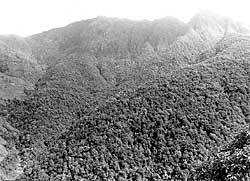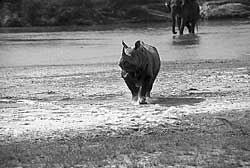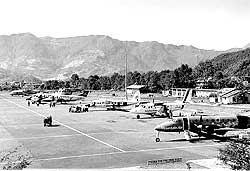 Nepal has lurched from one crisis to another since the restoration of democracy in 1990. The latest is the declaration of a state of national emergency. But however bleak things may look, Nepal has forged ahead in many areas with innovative development initiatives, and pioneering rural development schemes that have sustained themselves over the years.
Nepal has lurched from one crisis to another since the restoration of democracy in 1990. The latest is the declaration of a state of national emergency. But however bleak things may look, Nepal has forged ahead in many areas with innovative development initiatives, and pioneering rural development schemes that have sustained themselves over the years.
- Despite headlines about deforestation, the Himalayan midhills have seen a dramatic return of forest cover in the past 15 years.
- Democracy may be in crisis in the capital, but local self-governance and the revolutionary Decentralisation Act have boosted grassroots development giving rural Nepalis the power to make the decisions that affect their daily lives.
- Until the emergency was declared, the Nepali media was perhaps the most free in South Asia. Nepal was the first country in the region to allow community FM stations and private broadcasters.
- The deregulation of Nepal's hydropower to foreign investors was also a South Asian first, it has allowed a slew of medium-scale projects to come on stream and ended chronic electricity shortage.
- Domestic aviation took a great leap forward with privatisation, improving services, reducing prices and providing valuable service to the tourism industry.
- More than a quarter of Nepal's land area is made up of national parks and protected areas.
Everytime there are floods in India and Bangladesh during the annual monsoon season, fingers are pointed at the denudation in the hills of the Nepal Himalaya. Researchers wrote books 20 years ago on how deforestation and soil erosion would turn Nepal into a desert before the end of the century. Not only did that not happen, Nepal is green again.
In 1993, the government passed the community forestry law which handed ownership and management of commons in rural areas to village committees. Villagers formed user groups to plant, protect and manage forests. Within years, denuded slopes had turned into lush forests in districts like Sindhupalchok, Kabhre, Dhading and Tanahu. Nepal's community forestry experts are now helping other countries in the world to replicate the success here.
Even though Nepal's aggregate forest cover has gone down-reflecting deforestation in the tarai plains-the resurgence of the canopy in the mid-hills is real. Says Bhumi Raman Nepal, one of the earliest activists for grassroots ownership of forests: "When we began lobbying to give forests back to communities two decades ago, we thought it would take 50 years for our dream to come true." Bhumi Raman is now the chairman of the Forest and Environment Conservation Group in Dhading district. "Just look at the trees now."
Think locally
Nepal's constitution says in its preamble that people should be allowed to participate in political decision-making. No one believed devolution of power could happen in a society with such strong feudal controls. But it did. Despite political wrangling, parliament passed a revolutionary law that would make decentralisation real. The Local Self-Governance Act (1998) broke traditional and cultural barriers, and transferred not just decision-making authority but also the right to frame local laws to elected village and district committees.
Implementation of the law has not been as fast as expected, but local governance units around the country have begun to exercise their new powers. And in places where this has happened, decentralisation has finally begun to deliver democracy. Starting next fiscal year, local bodies will be allowed full authority to plan and implement projects for agriculture, postal services, primary education and basic health care.
In a country where the central government has lost credibility, this could be the answer to Nepal's ills, including the Maoist insurgency. "Where decentralisation has worked, there have been little problems even from the Maoists," Krishna Prasad Sapkota of the Kavre District Development Committee told us recently. "What happens when people's expectations are raised and there is no delivery?" he asks, and answers: "It will just turn young people into extremists."
The vision thing
Unnoticed, by the rest of the world, Nepalis have also mastered the craft of providing low-cost, reliable and world-class ophthalmologic care. Twenty years ago, if Nepalis developed cataracts they either went blind or had to go to India for treatment. Today, thousands of patients from India line up at Nepali eye hospitals and specialised centres in the tarai for treatment.
It is one of those little-known success stories of development, today Nepal is a regional leader in eye care. In 1981, there was only one eye hospital in Nepal, today there are 17 hospitals and 32 other eye care centres. Sanduk Ruit, is the director of the Nepal Eye Program who pioneered low-cost modern cataract surgery, and has trained doctors in Eritrea, Cambodia, China, Vietnam and Burma. He says: "In a country like ours, the trick is to provide realiable service cheaply."  Wild successes
Wild successes
In November 2000, Nepal showcased its successes in wildlife conservation by holding a major conference of the World Wildlife Fund (WWF). And there was a lot to be proud of: the rescue of Nepal's one-horned rhinoceros from the brink of extinction, the dramatic comeback of the Royal Bengal Tiger in Chitwan, research on the elusive snow leopard, the conversion of nearly a quarter of Nepal's territory into national parks, and successes of eco-tourism models like the Annapurna Area Conservation Project (ACAP).
Conservationist Chandra Gurung is a pioneer in some of these efforts, and has seen dramatic changes. "Today, Nepal is a leader in community based conservation in Asia. In 1988, seven percent of the income from tourism in ACAP went directly to communities there, today nearly half of it does," says Gurung, who is now the Nepal representative of WWF. Since 1961, the number of rhinos in the Royal Chitwan and Royal Bardia National Parks has grown six-fold to more than 600. Tigers which numbered less than a hundred have now gone up to 350, and 125 of them are breeding adults.
In the Annapurnas, the King Mahendra Trust for Nature Conservation is implementing a unique eco-tourism project that ploughs tourism income directly into the village economy to boost incomes and foster education and conservation. Learning from the Annapurna project, conservationists have replicated the eco-tourism model in Malaysia, Costa Rica and other areas.
WWF and the government are now gearing up to implement the ambitious India-Nepal crossborder Tarai Arc Landscape (TAL). Jungle habitats of Nepal and India will be joined into a contiguous forest for tigers, rhinos and wild elephants. TAL will spread over 49,500 sq. kilometres starting from the Bagmati in the Nepal tarai to the banks of Yamuna River in India.
Flying high
Till the early 1990s getting an air ticket on a Royal Nepal Airlines flight to a domestic destination was like winning a lottery. Seats were scarce and only government officials could fly without hassles. Today, the domestic airline network has expanded, private competition has brought down fares somewhat, but more importantly, flying has never been easier. All this is a result of the deregulation of domestic aviation in 1992.
 "Compared to other SAARC countries, the government here was more positive about private investment in airlines because it encouraged growth," says Narayan Singh Pun, an MP who runs his own helicopter company and an airline. "Now we need to update the policy to ensure that we can sustain the industry." This year's tourism slump has hit aviation the hardest. But the ones that are doing the best are those who had invested in domestic aviation and did not just rely on tourism.
"Compared to other SAARC countries, the government here was more positive about private investment in airlines because it encouraged growth," says Narayan Singh Pun, an MP who runs his own helicopter company and an airline. "Now we need to update the policy to ensure that we can sustain the industry." This year's tourism slump has hit aviation the hardest. But the ones that are doing the best are those who had invested in domestic aviation and did not just rely on tourism.
Brain gain
Till the 1980s, Nepal had no medical schools other than the Tribhuvan University Teaching Hospital in Kathmandu. There used to be just one engineering college running under-graduate level courses. Today, there are more than 12 medical and engineering colleges catering to the increasing need for technical expertise. Some of these schools are among Asia's best. In 1998, Thailand's Asian Institute of Technology (AIT) ranked technical schools on the basis of the performance of their alumni in campuses. Nepal's oldest engineering school, the Institute of Engineering (IOE) Pulchowk has consistently ranked in the top ten. Last year it was ranked third in Asia in terms of calibre of graduates.
This change had partially reversed a dominant trend of Nepalis heading to India, Pakistan or Bangladesh for higher technical studies. Today, Nepali medical schools have foreign students from the Maldives, India, Bangladesh and Sri Lanka.
Power to the people
One of the most dramatic successes of the government's new investment policy was a paradigm shift in 1992 that prioritised medium-scale investments in cheap and quick power projects. "With political pluralism in 1990 hydro-generation also became pluralistic," recalls water expert Ajaya Dixit, "It provided an alternative to government-led development thinking." Despite development, only 15 percent of the population has access to electricity but with present trends, this is bound to increase in the years ahead. Problems of high tariffs and mismanagement exist, but compared to other countries in the region Nepal now has reliable and adequate power for the foreseeable future. Aside from larger projects, Nepal is also a model for the development of indigenously designed micro-hydro plants in the 5-20 kilowatt range which can easily be installed at sites with traditional water mills. Nepali micro-hydro technology has been exported to Lesotho, Sri Lanka and to parts of India.


